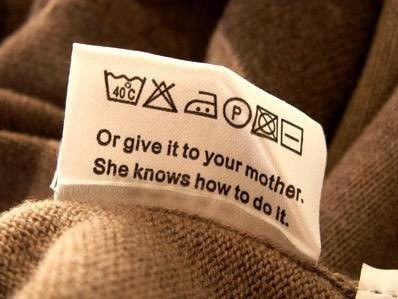How to Read the Care Label

Elli Share believes passing on the pre-loved clothes, but how do we care for clothes once we get them? Raise your virtual hand if you just throw things in the washer without reading all the little symbols on the labels? Or do you really rely on your mother for proper clothes care?...🤨
On the little label that sometimes makes your side body itchy, there are 5 symbols that tell you what you can and cannot do to the garment.

Washing
Several variations are available for washing. If the symbol also contains a number, it refers to the maximum temperature in Celsius allowed for washing. Most garments should be washed cold, which is both good for the garment and the environment. Things like bed sheets and other white things could be washed at above 60 degrees.
The symbol with the little hand means that hand washing is recommended. Natural fabrics such as wools, silks, and fine fabrics are better hand-washed. However, you don’t necessarily need to wash them by hand. Most washings machines have “Hand Wash” built-in, which means that it is a gentle cycle that does not spin too much. If a garment is labeled with “Do Not Wash”, you might want to reconsider the purchase.
If you see a bar underneath the symbol, it represents that the garment is delicate and should be washed in the “delicate” cycle. Normally these garments are better dried lying flat to protect its shape.
Tips from Justine: Natural fibers clean themselves naturally. Unless you have been riding your bike uphill for half an hour straight and sweating like crazy, you don’t need to wash your wool sweater. Mild smells will go away if you hang your clothes somewhere with good air circulation. Speaking of wool, make sure you always wash them with cold water and do not tumble dry.
Bleaching
This is a tricky one. Before deciding to bleach any garment, make sure that your machine is clean and rule out the possibility that previous wash cycles are causing the whites to look grey. If bleaching is required, make sure that non-bleachable items are excluded from the clothes.
Tips from Justine: drying your white clothes under the sun. Sunlight is a natural bleach, so it is definitely not friendly to colored clothes. However, white garments can enjoy as much sunshine as possible and you will get very white garments.
Drying
In general, fabrics do not like to be tumble dried, but we humans do! Who doesn’t enjoy the freshly dried clothes that are still warm from the dryer? Well, sometimes you gotta make a trade-off between convenience and preserving your super expensive garments.
Ironing
Contrary to what you might think, ironing and non-ironing usually do not have too much to do with natural or synthetic fabrics these days. Modern synthetic fibers can usually be ironed without too much hassle. Items that cannot be ironed usually have prints or sequins on. When ironing, make sure to use the correct heat level, indicated by the number of dots in the symbol. Three dots means that you can steam and iron on high heat without any problem. Obviously, it goes without saying that you should never leave the iron on the clothes for too long and blame the symbol for not telling that…
Dry cleaning
Many garments will have dry clean as the recommended way of cleaning. However, there is a difference between “Dry Clean” and “Dry Clean ONLY”. “Dry Clean” simply means that it is the recommended method of cleaning, but it is not the ONLY way. You can get away by doing a cold hand wash cycle but remember to skip the dryer.
Souce: Justine Leconte Official
0 comments
